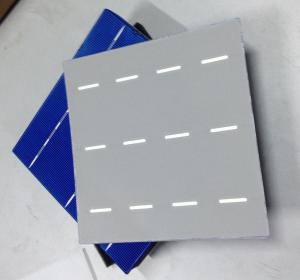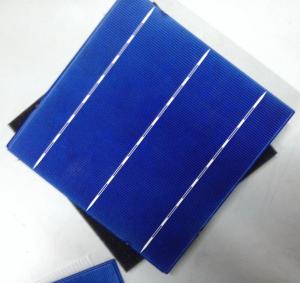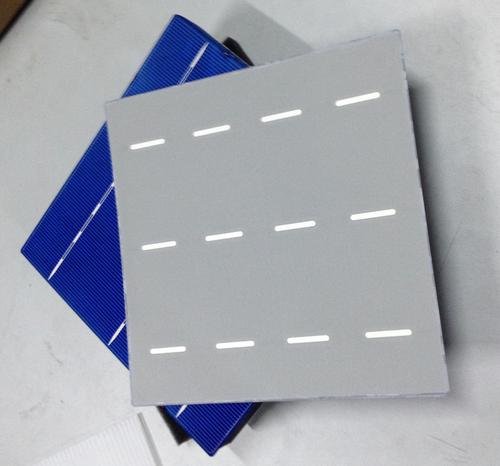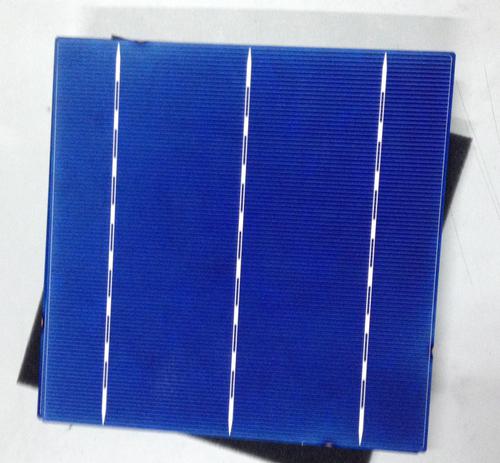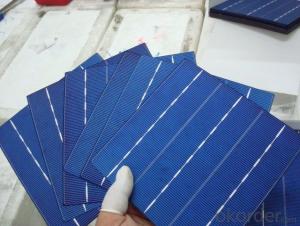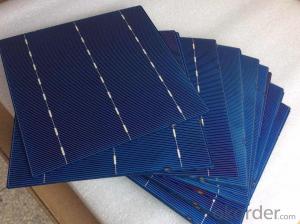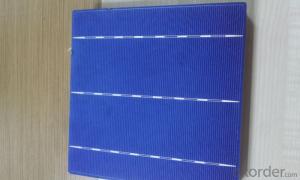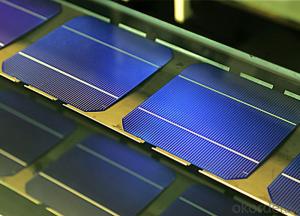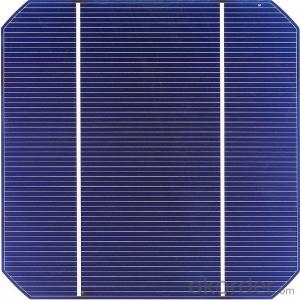Best Solar Cells - Polycrystalline Solar Cells Tire 1 Manufacturer -17.4%
- Loading Port:
- Shanghai
- Payment Terms:
- TT OR LC
- Min Order Qty:
- 10000 pc
- Supply Capability:
- 50000000 pc/month
OKorder Service Pledge
OKorder Financial Service
You Might Also Like
Specifications of Poly Solar Cells
Format 156 mm × 156 mm ± 0.5 mm
Thickness- 210μm ± 40 μm
Front (-) 1.5mm bus bars (silver),blue anti-reflection coating (silicon nitride)
Back (+) 2.5mm wide soldering pads (silver) back surface field (aluminium)
Temperature Coefficient of Poly Cells
Voc.Temp .coef.%/K -0.351%/K
Isc.Temp .coef.%/K +0.035%/K
Pm.Temp. coef.%/K -0.47%/K
Electrical Characteristic of Poly Cells
| Efficiency | Efficiency | Pmax(W) | Average | Impp(A) | Vmpp(V) | Isc(A) | Voc(V) |
| 1720 | 17.20~17.40 | > 4.186 | > 4.186 | 7.94 | 0.528 | 8.515 | 0.626 |
| 1700 | 17.00~17.20 | 4.137~4.186 | 4.161 | 7.905 | 0.525 | 8.482 | 0.624 |
| 1680 | 16.80~17.00 | 4.088~4.137 | 4.113 | 7.863 | 0.521 | 8.402 | 0.623 |
| 1660 | 16.60~16.80 | 4.040~4.088 | 4.064 | 7.825 | 0.519 | 8.358 | 0.622 |
| 1640 | 16.40~16.60 | 3.991~4.040 | 4.015 | 7.769 | 0.517 | 8.304 | 0.621 |
| 1620 | 16.20~16.40 | 3.942~3.991 | 3.967 | 7.713 | 0.514 | 8.248 | 0.619 |
| 1600 | 16.00~16.20 | 3.894~3.942 | 3.918 | 7.67 | 0.511 | 8.204 | 0.616 |
Advantages of Poly Solar Cells
1. High efficiency and High power.
2. Long-term electrical stability.
3. Lowest price and Fastest delivery.
4. Good quality and good service.
5. Bulk supply
6. Good Warranty
7. Big Sale
8. More than 25 years on the lifetime.
Usage and Applications of Poly Cells
Solar cells are often electrically connected and encapsulated as a module. Photovoltaic modules often have a sheet of glass on the front (sun up) side, allowing light to pass while protecting the semiconductor wafers from abrasion and impact due to wind-driven debris, rain, hail, etc. Solar cells are also usually connected in series in modules, creating an additive voltage. Connecting cells in parallel will yield a higher current;our solar cells have passed IEC Certification. With high quality and stable quality. Our Cells can greatly improve the performance of Solar Modules.
Packaging & Delivery of Poly Cells
Carton Box Package and Deliver by air. It should be noticed that it should be avoid water, sunshine and moist.
Factory Picture of Solar Cells
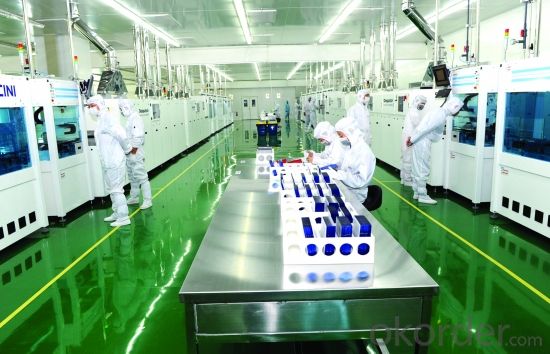
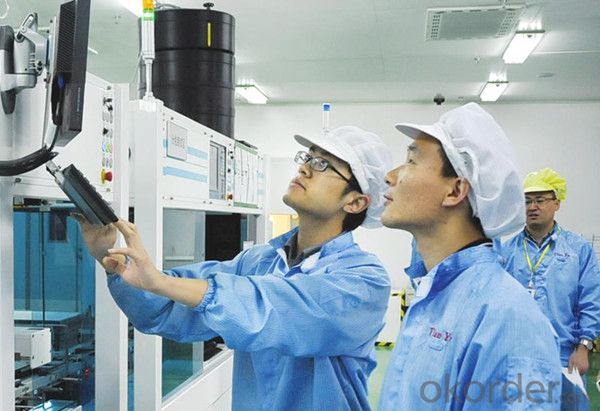
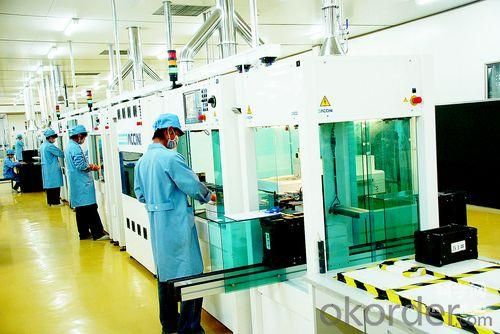
FAQ
We have organized several common questions for our clients,may help you sincerely:
1. What’s price per watt?
A: It’s depends on the quantity, delivery date and payment terms of the order. We can talk further about the detail price issue. Our products is high quality with lower price level.
2. Can you tell me the parameter of your solar cells?
We have different series of cells with different power output, both from c-si to a-si. Please take our specification sheet for your reference.
3. How do you pack your products?
We have rich experience on how to pack the panels to make sure the safety on shipment when it arrives at the destination.
4. Can you do OEM for us?
Yes, we can.
5. How long can we receive the product after purchase?
In the purchase of product within three working days, We will arrange the factory delivery as soon as possible. The perfect time of receiving is related to the state and position of customers. Commonly 7 to 10 working days can be served.
- Q: How do solar cells perform in areas with high levels of humidity?
- Solar cells generally perform slightly less efficiently in areas with high levels of humidity. This is because the moisture in the air can scatter and absorb some of the sunlight before it reaches the solar cell, reducing its overall power output. However, modern solar cell technologies have been developed to minimize this effect and maintain a satisfactory performance even in humid conditions.
- Q: Can solar cells be used for powering electric vehicles charging stations?
- Yes, solar cells can be used for powering electric vehicle charging stations. This is known as solar-powered charging infrastructure, which utilizes solar panels to convert sunlight into electricity, which is then used to charge electric vehicles. This approach provides a sustainable and renewable energy source for EV charging, reducing reliance on non-renewable energy sources and decreasing environmental impact.
- Q: How to generate solar cells, the principle of PN junction
- Solar energy is an inexhaustible renewable energy source for human beings, and it is clean energy and does not produce any environmental pollution. In the effective use of solar energy; solar energy photoelectric utilization is the fastest growing and most dynamic in recent years
- Q: How do solar cells perform in areas with frequent power outages?
- Solar cells can provide a reliable source of electricity in areas with frequent power outages. As long as the solar panels are exposed to sunlight, they can generate electricity and charge batteries, allowing for uninterrupted power supply even during blackouts. Additionally, solar power systems can be equipped with backup batteries, ensuring a continuous and reliable energy source even after sunset or during cloudy days. Overall, solar cells are a viable solution for areas prone to power outages, providing sustainable and independent electricity generation.
- Q: What is the lifespan of solar cells?
- The lifespan of solar cells can vary, but on average, they are designed to last for 25 to 30 years.
- Q: What is the role of solar cells in powering electric vehicles?
- Solar cells play a crucial role in powering electric vehicles by converting sunlight into electricity. These cells are typically mounted on the roof or body of the vehicle, absorbing sunlight and generating electrical energy. This energy is then used to charge the electric vehicle's battery, providing an additional source of power and extending its range. Although solar cells alone may not be sufficient to fully power an electric vehicle, they help reduce reliance on traditional charging methods and promote sustainable and renewable energy usage.
- Q: I have a turnkey solar power project starting in 6 months, now we are searching the market in south China to find the best solar cells manufacturers. Any professional suggestion or recommendation?
- I suggest you select at least 7 solar cells manufacturers based in this area, and ask them to send their company introductions and quotation to your office, and have a face-to-face meeting. Make sure what you see is what you get.
- Q: Can solar cells be used for powering agricultural equipment?
- Yes, solar cells can be used for powering agricultural equipment. Solar panels can convert sunlight into electricity, which can then be used to power various agricultural machinery such as irrigation systems, pumps, electric fences, and even tractors or vehicles. Using solar power for agricultural equipment can help reduce reliance on fossil fuels, lower operational costs, and promote sustainable farming practices.
- Q: What are the safety considerations when installing solar cells?
- Some safety considerations when installing solar cells include proper handling and installation of the panels to avoid any physical injuries, ensuring the electrical connections are secure and properly insulated to prevent electric shocks or fires, and following necessary protocols and guidelines to protect against potential hazards such as falls from heights or exposure to harmful chemicals. Additionally, it is important to have a qualified professional install the solar cells to ensure compliance with local building codes and safety standards.
- Q: Can solar cells be used for powering traffic lights?
- Yes, solar cells can be used for powering traffic lights. Solar panels can generate electricity from sunlight, which can then be stored in batteries and used to power traffic lights without the need for a traditional electrical grid connection. This is an environmentally-friendly and cost-effective solution for powering traffic lights in areas where it may be challenging to provide a constant power supply.
Send your message to us
Best Solar Cells - Polycrystalline Solar Cells Tire 1 Manufacturer -17.4%
- Loading Port:
- Shanghai
- Payment Terms:
- TT OR LC
- Min Order Qty:
- 10000 pc
- Supply Capability:
- 50000000 pc/month
OKorder Service Pledge
OKorder Financial Service
Similar products
Hot products
Hot Searches
Related keywords
